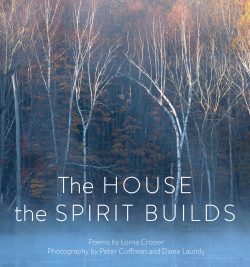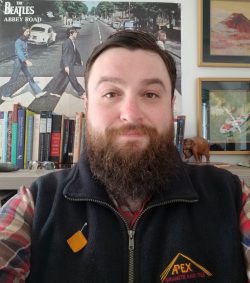#654 When images yield poems
The House the Spirit Builds
by Lorna Crozier, with Peter Coffman and Diane Landy (photography) and Rena Upitis (introduction)
Madeira Park: Douglas & McIntyre, 2019
$22.95 / 9781771622417
Reviewed by Paul Falardeau
*
 The natural world has long been de rigueur to the life of poets and artists, the Chinese poet Han Shan (寒山, literally Cold Mountain), scrawling his writing on the walls of caves and slopes of his namesake, comes to mind. In the past few decades, we have seen this transform from a closeness and appreciation of the wild to an embattled struggle for the preservation of Earth’s environment. Writers like Gary Snyder, Lew Welch, and Joanne Kyger led a movement of poetics of ecoconsciousness in 1950s and 60s, while the surge of Indigenous voices reclaiming space in Canadian literature has brought with it a similar respect and recentring of indigeneity and the natural world, consistent with these longstanding ways of understanding, that demands an obligation to act as stewards and protectors. The environment has gone from fringe concern to the hot topic of the 2019 Canadian federal election.
The natural world has long been de rigueur to the life of poets and artists, the Chinese poet Han Shan (寒山, literally Cold Mountain), scrawling his writing on the walls of caves and slopes of his namesake, comes to mind. In the past few decades, we have seen this transform from a closeness and appreciation of the wild to an embattled struggle for the preservation of Earth’s environment. Writers like Gary Snyder, Lew Welch, and Joanne Kyger led a movement of poetics of ecoconsciousness in 1950s and 60s, while the surge of Indigenous voices reclaiming space in Canadian literature has brought with it a similar respect and recentring of indigeneity and the natural world, consistent with these longstanding ways of understanding, that demands an obligation to act as stewards and protectors. The environment has gone from fringe concern to the hot topic of the 2019 Canadian federal election.
Inevitably poets have reinvigorated their relationship with environmental discussions and ideas in their work, now almost ubiquitous in contemporary poetry. In 2015, celebrated University of Victoria poet Lorna Crozier released (with Ian McAllister) The Wild in You: Voices from the Forest and Sea (Greystone Books), which combines photography and poetry, bringing a fresh approach to the genre. Now, four years later, The House the Spirit Builds, continues the idea, this time in a biosphere on the other side of the country.

Lorna Crozier is the recipient of the Governor General’s Award for Poetry and the Pat Lowther Award, and is a fellow of the Royal Society of Canada, amongst many other awards and distinctions in a career made by capturing small moments and big ideas. That continues in The Wild in You and The House the Spirit Builds. What sets these collections apart from her previous work is the combination of her writing and her collaborators’ world-class photography. Each new page sets one of Crozier’s poems against the photo that inspired it. Where The Wild in You inspired with its raw beauty of the wild coast of British Columbia, The House the Spirit Builds builds on the concept. In it, Crozier and photographers Peter Coffman and Diane Laundy capture the Frontenac Arch Biosphere Reserve in Southeastern Ontario. Situated at the junction of the Canadian Shield and the St. Lawrence Valley, Spirit centres itself around Wintergreen Studios, an artist’s retreat in Frontenac Arch Biosphere.
The House the Spirit Builds finds itself less often walking along rugged shorelines populated with wolves and sea lions – the Great Bear Rainforest of Ian McAllister — and more often considers country roads, frog ponds, or a bowl of oranges on the kitchen table in a rustic Ontario cottage. In other words, The House the Spirit Builds centres on the nexus of the natural and human worlds; of the untamed and the creative; of the solid and the ethereal. There are still many wild places to explore in this new biosphere, but its seems that Crozier and company now wish to consider not just the majesty of the wild, but how humans might conceivably exist within it.

The resulting book is, first and foremost, beautiful. The photography of Coffman and Laundy should earn this collection a place in homes everywhere. The poems Crozier elicits from their work add a multimodality to the overall achievement that makes it easy for readers to feel transported to this precious place. The process feels akin to jazz musicians jamming, playing licks off each other, evolving their sound each out of the other. It is a fitting way to approach such a task as Spirit proposes and works wonders. For example, across from a picture of mist rising through a stand of birch, Crozier’s poem, “A Small Ambition,” aims “to be no more than mist/ rising above the rushes,/ entering the white limbs of trees./ For just one hour/ to be a calmness, a lifting up/ minus bones and muscles,/ minus memory/ and cognition/ and your own insistent/ longing to last.” The pairings are not always so on the mark either. “Camera Questions,” paired with a shot of a dead tree floating on water, is a consideration of the limitations of photography that compares photographs to owl-pellets, “their once-alive/ put-togetherness/ now jumbled up/ out of whack.”
If photography as a discipline struggles with capturing the “put-togetherness” of its subjects, poetry is not innocent either. Yet the combination of the two seems to give the reader something of a chance for deeper discussions. While both inherently frame something that is probably impossible to sum up in a few words or snaps, the combination makes those unnatural walls porous. Because Crozier gets to let her mind wander with a beautifully positioned photograph of lily pads, and to imagine a lost work of Monet, the artifice of what the photographer chose to show is lessened, and both the poem and the picture are deepened by this freedom. This might not work so well if photographer and poet were disconnected, but they are linked through the intimacy they achieve with the wild lands around Wintergreen in a connection that becomes a language they both speak. Ultimately, their combined effort is something greater than the sum of its parts. Where a photograph delicately captures a drop of rain on a stalk of grass, Crozier muses that, “rain stops falling/ but/ hangs around/ like the shape of lust/ in bedsheets.”

The House the Spirit Builds Highlights the beauty of the natural world and the place humankind has in it. The opportunity here is to be larger than ourselves when we let ourselves go in moments of exaltation. “When the dragonfly lands and grips the skin/ on the back of your hand,” Crozier writes to illustrate this point, “with the exact weight-/ lessness specific to its kind,/ you know it’s too alive to be a man-made thing.” The titular poem is paired with a photograph of a glass door that both looks out at the woodland and is saturated by its reflection in the beams of sunlight streaming through its panes. Crozier sums up the developing philosophy: if humans are to find a way to coexist with the natural world and save it for generations to come, we must learn that it is not only something something admirable, yet separate. We are the wild, and it is us:
Its last time on earth
this soul occupied a human. No wonder,
back with us, it longs for a house
with window after window
after window
as if in its return
it will live inside an old one
looking out,
or in a moth, a bluebottle
fly, a pair of glasses
that gawks without eyes
at the slant of the sun
sliding through, and in its path,
smaller than fireflies,
the hundreds of motes
that will survive
any fear or flesh or laughter.




*

Paul Falardeau is a poet, essayist, brewer and most recently, an English teacher, living in Vancouver, a city on the unceded lands of the Musqueam, Squamish and Tsleil-Waututh First Nations, whom he offers respect and gratitude. He is a graduate of University of the Fraser Valley and Simon Fraser University. He has published in Pacific Rim Review of Books, subTerrain, and Cascadia Review, and he contributed an essay to Making Waves: Reading B.C. and Pacific Northwest Literature (Anvil Press, 2010).
*
The Ormsby Review. More Books. More Reviews. More Often.
Publisher and Editor: Richard Mackie
The Ormsby Review is a journal service for serious coverage of B.C. books and authors, hosted by Simon Fraser University. The Advisory Board consists of Jean Barman, Robin Fisher, Cole Harris, Wade Davis, Hugh Johnston, Patricia Roy, David Stouck, and Graeme Wynn. Scholarly Patron: SFU Graduate Liberal Studies. Honorary Patron: Yosef Wosk. Provincial Government Patron since September 2018: Creative BC
“Only connect.” – E.M. Forster
